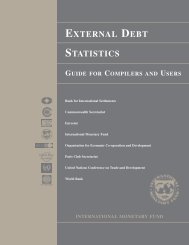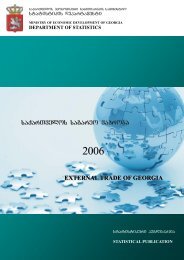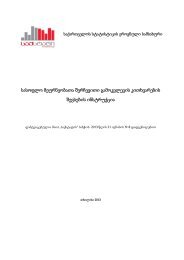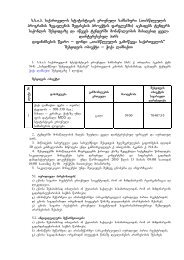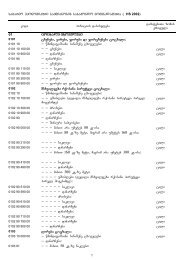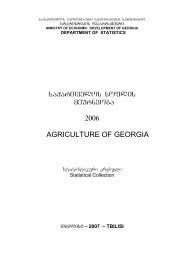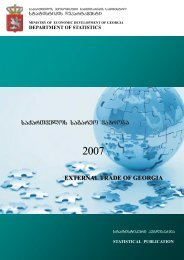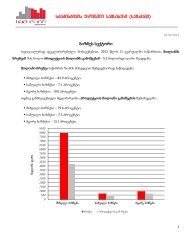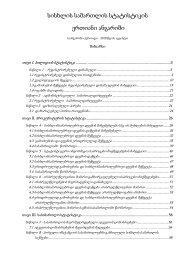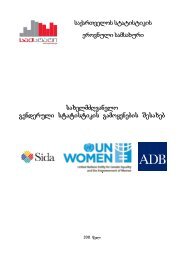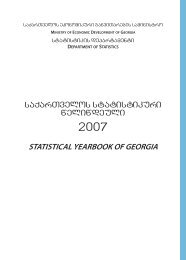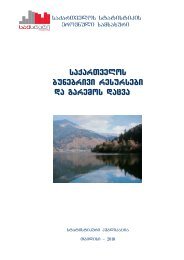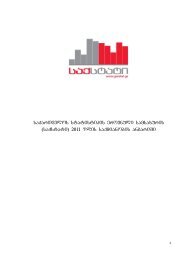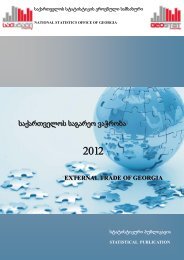FDI short methodology ENG.pdf - GeoStat.Ge
FDI short methodology ENG.pdf - GeoStat.Ge
FDI short methodology ENG.pdf - GeoStat.Ge
Create successful ePaper yourself
Turn your PDF publications into a flip-book with our unique Google optimized e-Paper software.
Brief Methodology and Practice of Calculationof Foreign Direct Investments (<strong>FDI</strong>) in <strong>Ge</strong>orgiaIn general investments are divided into three functional categories: Foreign Direct Investments (<strong>FDI</strong>),Portfolio Investments and Other Investments.<strong>FDI</strong> represents an important component of the most important financial instrument of our country – Balanceof Payment. It was calculated in <strong>Ge</strong>orgia in accordance with <strong>methodology</strong>, Balance of Payment Manual,prepared by the International Monetary Fund (IMF) (IMF, Washington, USA, 1993, Fifth edition) since 1997and now it is calculated in accordance with Balance of Payment and International Investment PositionManual, (IMF, Washington, USA, 2008, Sixth edition). Besides, for the purposes of accurate definition of<strong>FDI</strong>, correct identification of production links and accurate calculations OECD Benchmark Definition ofForeign Direct Investment (Organisation for Economic Cooperation and Development (OECD), Paris,France, 2008, Fourth edition) as well as The Coordinated Direct Investment Survey Guide, issued by theIMF in December 2008, are used.<strong>FDI</strong> is a category of cross-border investment associated with a resident in one economy having control or asignificant degree of influence on the management of an enterprise that is resident in another economy.Direct investment covers not only initial transaction of capital investment, but also all further transactionsbetween direct investor and direct invetment enterprise.Investor, who owns no less than 10% of the shares of an enterprise or equivalent of such participation, isregarded as a direct investor. Direct investors may be individuals, incorporated or unincorporated private orstate owned entities.Main sources of information on <strong>FDI</strong> are quarterly and annual statistical surveys on external economicactivities of enterprises conducted by <strong>Ge</strong>ostat. In addition to this information is received from the Ministry ofEconomy and Sustainable Development of <strong>Ge</strong>orgia and Ministry of Finance and Economy of AjaraAutonomous Republic on entities privatized by non-residens. National Bank of <strong>Ge</strong>orgia collects, processesand quarterly submits to <strong>Ge</strong>ostat information from financial sectors of <strong>Ge</strong>orgia, namely information on <strong>FDI</strong>sin commercial banks, insurance companies and micro finance organizations.The statistical surveys on external economic activities of enterprises currently involve all regions of <strong>Ge</strong>orgia(controlled territories) and up to 2,000 entities. Selection of the entities for the survey is based on thefollowing criteria:- an enterprise has non-resident founder;- conducts export-import transactions’- has taken a loan from non-residents or has given loan to non-residents;- has deposits at non-resident banks;- owns 10% and more of equity capital of a non-resident enterprise;- renders service to or receives service from non-residents.The list of selected companies is updated quarterly by activities and classification of founders.
<strong>FDI</strong> can be broken down into the following three categories: equity capital, reinvestment and other capital.The data has been processed by investor countries since 1997. The survey instruments (questionnaires)undertook certain changes in 2007, which allowed to process data by sectors of economy as well based onprincipal activities of enterprises. Information on <strong>FDI</strong> can be presented by types of various informationsources as well.Preliminary data are published quarterly, on the 70 th day after completion of the reporting period.Preliminary annual data is generated by summing up four quarter data. The preliminary annual data iscorrected on the basis of annual survey data on August 15 of the next year.Adjusted data always differs from the preliminary ones. One of the main reasons is that enterprises submitadjusted income statement indicators once a year.The discrepancy between preliminary and adjusted data sometimes exceeds 20% in quarterly trendsbecause <strong>FDI</strong> is not just an investment in fixed assets. It is a financial category and its positive and negativevalue fall under international methodological framework and standards.In general, the reasons for reduction of <strong>FDI</strong> could be: selling shares by non-resident to a resident, reclassificationof non-resident direct investor to portfolio investor, reduction of liabilities towards non-residentdirect investor by a resident enterprise.If we review trend of <strong>FDI</strong> over a long period of time we will see that <strong>FDI</strong> in the second half of a yearexceeds that of the first half not only in <strong>Ge</strong>orgia but also in other countries of the world.Note: Detailed <strong>methodology</strong> is available at: http://geostat.ge/index.php?action=page&p_id=745&lang=geo



